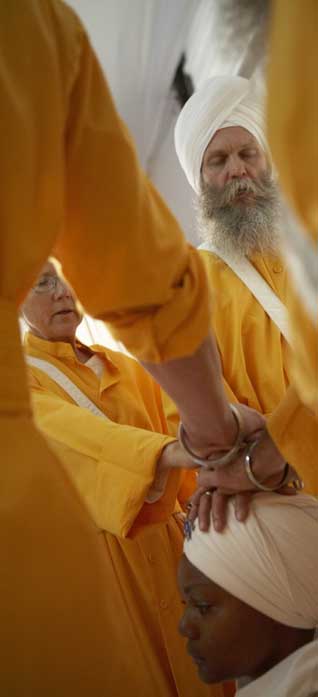Faith
The Khalsa Transformation
KULBIR KAUR
Khande da Pahul or, in simple terms, called “Amrit-Chhakna” (to partake nectar) is the Sikh ceremony of initiation which is of immense socio-religious significance.
Khande de Pahul is like taking a new birth with a transformed physical, mental and spiritual faculties. It is a journey from a mundane to a spiritual field of life, though remaining within the householder’s way of life.
The Sikh coming-of-age ceremony is open to all. Any person of any caste, class, gender, religion or nation can embrace it and become a “pure” new person by becoming a member of the Khalsa.
The ceremony was started by Guru Gobind Singh in 1699 when, on the day of Vaisakhi, he gave Amrit to the “Five Beloved” ones (Punj-Pyare). The turning point of the ceremony was a request by the Guru himself to the Five to initiate him into Khalsahood.
And lo and behold, no distinction was left between the Guru and the disciples and followers, the self and the supreme.
Such is the power of this ceremony!
The initiation ceremony can be conducted at any quite place in the presence of the Guru Granth Sahib and six amritdhari Sikhs, male or female -- one granthi to read from the Guru Granth and five Sikhs to administer the Khande da Pahul.
Everyone, the seeker and those administering it, must take a bath and wash their hair prior to the ceremony. With their heads covered and the Five Kakkars adorning their bodies, the persons seeking initiation must stand respectfully with hands folded facing the Guru Granth Sahib.
One of the five ‘beloved ones’ explains the main rules and obligations of the Khalsa Panth. These are to meditate only on the One Supreme Creator and renunciation of the worship of any created thing; study and live according to the Sikh teachings, and to help and serve humanity at large.
The Sikhs, waiting to be initiated, are then asked if they are willing to abide by these rules. On an affirmative response, the ceremony starts with an ardaas and the preparation of the amrit (nectar) starts after taking hukam (command) from the Guru Granth Sahib.
Amrit is prepared in a pure iron/steel bowl filled with clean water and some patashas (sugar puffs). The Punj Pyare position themselves around the bowl in the bir asan (the posture of a warrior with the left knee raised and the right knee touching the ground) and while stirring the bowl with a double-edged sword (Khanda), the five Sikhs recite gurbani.
The seekers or the initiates should each place both hands on the bowl and concentrate and meditate. After the completion of the prayers and the ardaas, the amrit is received by the Sikhs while sitting in the bir asan posture and with the hands cupped, right hand on the left.
Amrit is received five times, splashed on the eyes and sprinkled into the hair. Each time after receiving the nectar, the person being initiated says, “Waheguru ji ka Khalsa, Waheguru ji ki Fateh.” The remaining nectar is shared by those receiving initiation, all drinking from the same bowl (men as well as women). Hence all the previous ties, impurities of the mind and body, and distinctions based on caste, religion, class and gender are removed.
Thus commences a new life, a new person -- a pure one.
The ceremony proceeds with the recitation of the Mool-Mantar -- “Ik Onkar, Satnam, Karta Purakh, Nirbhau, Nirvair, Akaal Moorat, Ajauni Saibhang, Gurprasad ... There is only one God, whose name is truth, the all-pervading creator, without fear, without hatred, immortal, unborn, self-existent, the grace incarnate”.
One of the Five then explains to the newly-born Khalsas, “From now on your existence as ordinary individuals has ceased, and you are members of the Khalsa brotherhood ... you have become the pure Khalsa ...”
Having explained all the rules in detail, ardaas is said and karaah parshad is distributed and the newly-initiated enter the new world of equality, purity, service and brotherhood.
* * * * *
The author teaches Sociology at Shyama Prasad Mukherji College, Delhi University.
[Courtesy: Asian Age. Edited for sikhchic.com]
May 31, 2017



